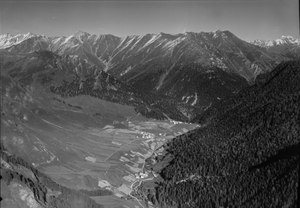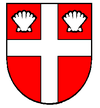Samnaun
![]()
This article is about the municipality in Switzerland. For the village in Tyrol, see Serfaus-Fiss-Ladis; see also Samnaun Group.
Samnaun (Rhaeto-Romanic ![]() or
or ![]() ) is a political municipality in the Engiadina Bassa/Val Müstair region, on the eastern northern edge of the Swiss canton of Graubünden. The municipality consists of the five fractions Compatsch, Laret, Plan, Ravaisch and Samnaun. Samnaun is a Swiss customs exclusion zone.
) is a political municipality in the Engiadina Bassa/Val Müstair region, on the eastern northern edge of the Swiss canton of Graubünden. The municipality consists of the five fractions Compatsch, Laret, Plan, Ravaisch and Samnaun. Samnaun is a Swiss customs exclusion zone.
History of the Samnaun Valley
The history of Samnaun is closely linked to that of the Lower Engadine. The first settlers, who came to the Samnaun valley between 800 and 1000 AD in search of new pastures, came from the Lower Engadin. In the families Romansh was spoken almost exclusively until about 1800. Today the Samnauner speak a Tyrolean dialect, which actually comes from South Bavarian and - with this very special colouring - can only be found in this valley.
Samnaun served as a Maiensäss and was later a fraction of the municipality of Ramosch. Therefore the history of Samnaun is largely identical with that of the Lower Engadine. The old Rhaeto-Romanic culture is evidenced above all by the place, field and mountain names.
The only connections to the outside world were the passes to the Engadine and Paznaun as well as an ox-cart track via Spiss to Pfunds. A lively trade with the neighbouring Tyrol developed via this ox cart path.
Despite the cultural influence from Tyrol, the linguistic conditions in Samnaun remained the same for centuries. In the families Romansh was spoken almost exclusively until about 1800. The last Samnauner who was still familiar with the Romansh language died in 1935.
The centralization of the Swiss customs system in 1848 put an abrupt end to trade with Tyrol. With this the inhabitants of Samnaun lost an important source of income. They submitted - first in 1888, then again in 1892, this time supported by the district office of Ramosch and the canton of Graubünden - an application to the federal authorities to exclude Samnaun from the Swiss customs territory. In 1892 the Federal Council complied with this request and Samnaun became duty-free. The Federal Council justified its decision above all with the absence of a direct access road over Swiss territory to Samnaun and with the increase in the cost of foodstuffs for the valley community caused by the customs duty. The status of duty-free was initially only to be granted until a direct connecting road to Switzerland was built. This was opened in 1912. Afterwards the status was extended and today secures many jobs not only in the Samnaun valley but also in the surrounding regions of the Lower Engadine and the Upper Court.

Historical aerial photograph by Werner Friedli from 1954
Coat of arms
|
| Blazon: "In red a continuous silver (white) cross, above removed by two silver shells. » |
| Justification of the coat of arms: The shells are grave goods of St. James, patron saint of the parish church of Samnaun-Compatsch, patron saint of the municipality of Samnaun. The cross forms a reference to the border community of Samnaun. The shells as a symbol of Saint James the Elder, patron of the parish church of Compatsch, are thus connected with the cross as a reference to the border community. |
See also: List of municipal coats of arms with the scallop shell in Switzerland
Search within the encyclopedia
